The hardest thing about concert photography is that the setting is usually pretty dark. The first thing you should do is increase the ISO--as high as your camera will allow. If you have a setting for ISO 1600 or 3200, dial it in. Yes, using a very high ISO will result in photos pocked with digital noise, but that's a necessary tradeoff. And digital noise is similar to the "grain" that you used to get in high-speed film, so it can lend a certain ambiance to your photos. Here is a shot of my son in a school concert, taken at 3200 ISO.
Take Great Photos at Night
Posted: July 17, 2012
Some of the best photo opportunities and natural phenomenon happen at night. If you've ever tried to capture them on film and failed, follow these tips to help your next try be a success.
Some of the best photo opportunities and natural phenomenon happen at night. If you've ever tried to capture them on film and failed, follow these tips to help your next try be a success.
Follow these photography tips to get exciting shots of the city in motion, capture lit-up buildings and monuments, and take photos in dimly lit concert halls and clubs.
Getting Started With Night Photography 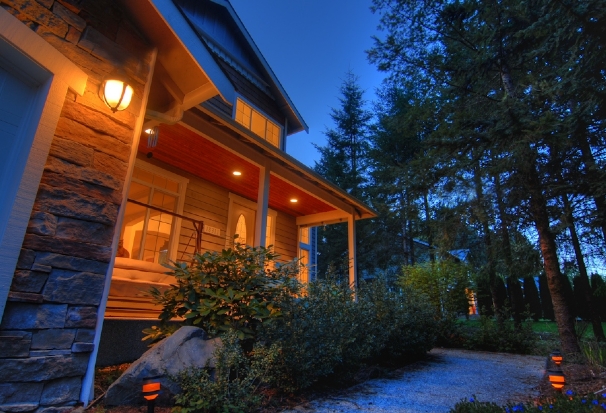
You might think of photography as a daytime hobby and resort to using the flash only when you need to shoot at night. But nighttime, with its velvety black backgrounds, light trails, and bright cityscapes, can actually make a compelling subject for your photos. Even if you don’t want to capture the illuminated commotion of a city street at night, you might still want to take concert photos or capture the action indoors when the lights are low. No matter the occasion, night photography is a handy skill to hone.
Essential Equipment: Cameras and Tripods
Almost any modern digital camera can take impressive night photos. Ideally, the camera should have a manual exposure mode that lets you dial in long shutter speeds (up to 30 seconds)--a point-and-shoot like the Canon PowerShot SX210 (shown here) or a digital SLR like the Nikon D5000 are ideal. Alternatively, check for a Night scene mode. It won't provide the same control, but it'll get you started in night photography. And you'll need a tripod. Since the exposure will be several seconds long, stabilizing the camera is essential. I also suggest using the self-timer or a remote control to trigger the shutter.
Capture the City in Motion
Now it's nighttime and you've got your camera on a tripod, pointed at an interesting scene--like this 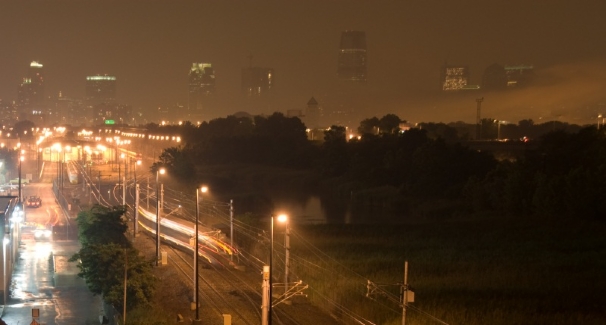 skyline with a passing train, for instance, or maybe a busy city street. If you have a manual mode, use it to set your camera's aperture to a middle setting (like f/8) and set a 4-second exposure. Take the shot and check the result in the LCD. This initial exposure might make your photo look overexposed. If you see that happening in your LCD after you take a photo, compensate in your next photo by using a smaller aperture setting (a larger f-number). And if you want longer light trails, lengthen the exposure to 8 or 15 seconds.
skyline with a passing train, for instance, or maybe a busy city street. If you have a manual mode, use it to set your camera's aperture to a middle setting (like f/8) and set a 4-second exposure. Take the shot and check the result in the LCD. This initial exposure might make your photo look overexposed. If you see that happening in your LCD after you take a photo, compensate in your next photo by using a smaller aperture setting (a larger f-number). And if you want longer light trails, lengthen the exposure to 8 or 15 seconds.
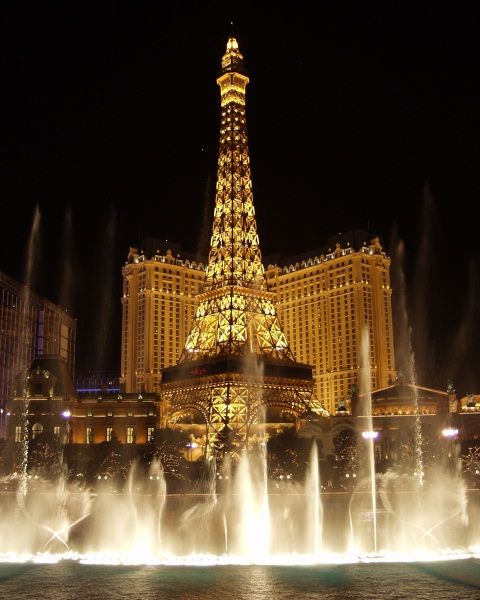 Bright Lights in the Big City
Bright Lights in the Big City
You can make the lights in your scene brighter by opening the aperture (dialing in a smaller f-number), and you can brighten the background by lengthening the shutter speed. You'll be able to get interesting shots with shutter speeds that range from about 1 second to 30 seconds. You can adjust subsequent shots by tweaking your exposure--changing the shutter speed, the aperture, or both. This photo, for example, relies on a 1-second exposure to illuminate the buildings and blur the water. For tips on photographing sparkly lights in motion, read "Photographing Fireworks: Tips and Tricks."
Dealing With Digital Noise
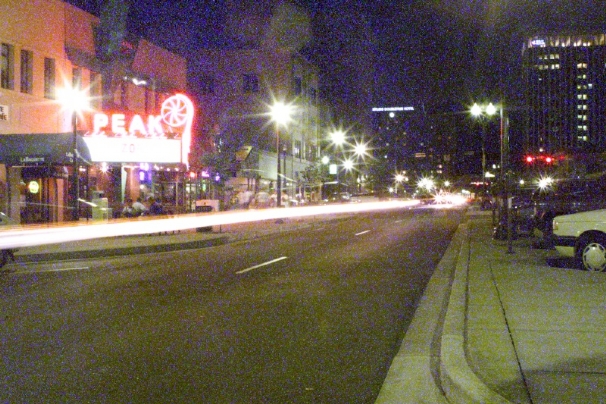
Digital noise is often an issue in night photography. In the same way that higher ISO values increase noise, long exposures--even at low ISOs--can also increase noise. You'll get the least noisy photos with a digital SLR or an advanced point-and-shoot camera. If you use a camera that spills noise all over the image when shooting long exposures (like the one I used for this shot), you'll want to use your image editor to clean up your photos; read "Reduce Digital Noise in Your Photos" to learn how.
Consider Shooting in RAW
Night photography is one of those situations in which shooting in your camera's RAW mode (if it has one) can be a real advantage. RAW mode captures significantly more color and brightness information than it's possible to display in a JPEG image. That means you can edit your photo afterwards to bring out shadow details that would be lost if you work exclusively in JPEG mode. Read "Using Your Camera's RAW Mode" for an example of how RAW can save a nighttime photo shoot.
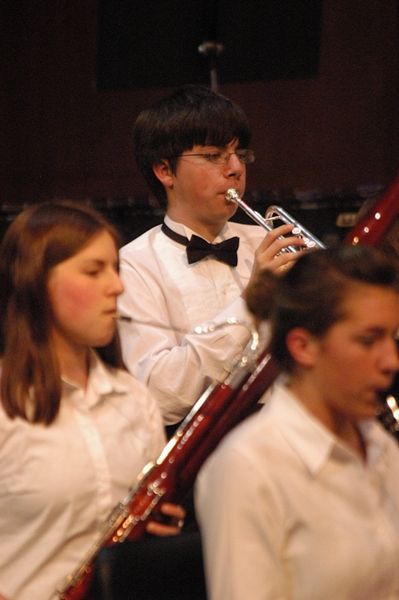 Shooting Concerts and Performances
Shooting Concerts and Performances
Go for a Fast Shutter Speed
A fast shutter speed is important if you want to capture the scene in a dark club or concert hall. In fact, that's why we use a high ISO--by making the sensor more sensitive to light, we can get a faster shutter speed in the dark. The easiest way to bump up the shutter speed is to use Program mode, which usually defaults to the fastest shutter possible in low light. If you set the shutter speed manually, dial in the fastest speed that you can--which might be only 1/15th or 1/30th of a second. In this picture taken in my own home, which was lit pretty well, you can see that I could not prevent some motion blur on Downpilot guitarist Paul Hiraga's strumming hand.
Ready, Steady--Shoot
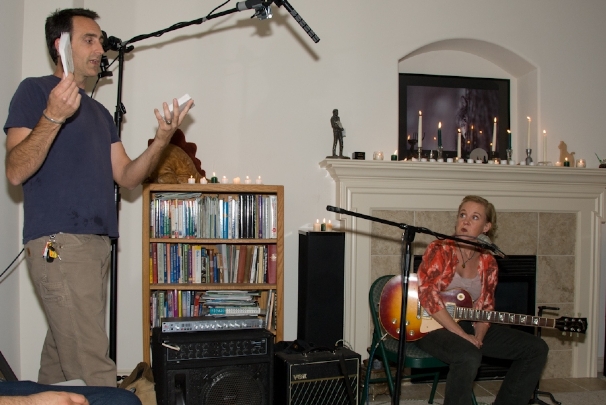 Once you've got your exposure locked in, it's time to freeze the action. If you aren't using a tripod, you should be extra careful to hold the camera securely and gently press the shutter release to minimize camera shake. Take a lot of pictures, trying to time your shots for times when the subject is as still as possible. Don't even try to capture the action when (for example) the guitarist struts across stage--it'll probably be a blur. I've had the best results during relatively quiet moments, as in this one where a speaker introduces singer/songwriter Kristin Hersh.
Once you've got your exposure locked in, it's time to freeze the action. If you aren't using a tripod, you should be extra careful to hold the camera securely and gently press the shutter release to minimize camera shake. Take a lot of pictures, trying to time your shots for times when the subject is as still as possible. Don't even try to capture the action when (for example) the guitarist struts across stage--it'll probably be a blur. I've had the best results during relatively quiet moments, as in this one where a speaker introduces singer/songwriter Kristin Hersh.
Biz Tip Provided by PCWorld
Written By Dave Johnson